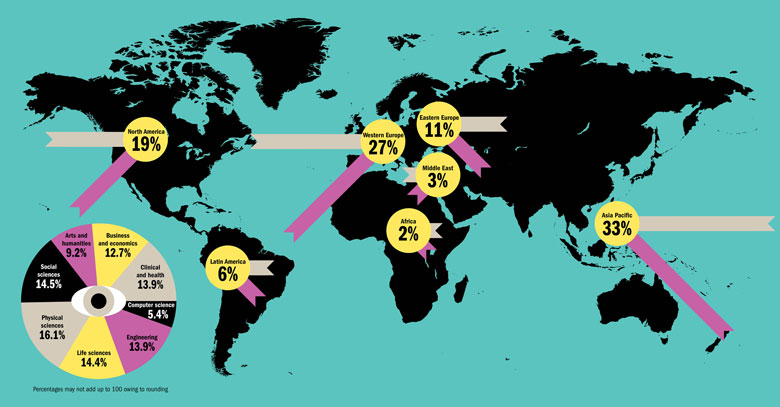View Times Higher Education's full list of the world's most prestigious universities
The Times Higher Education World Reputation Rankings are created using the world’s largest invitation-only academic opinion survey – a unique piece of research.
The Academic Reputation Survey, available in 15 languages, uses United Nations data as a guide to ensure the response coverage is as representative of world scholarship as possible. It is also evenly spread across academic disciplines.
The questionnaire, administered on behalf of THE by Elsevier, targets only experienced, published scholars, who offer their views on excellence in research and teaching within their disciplines and at institutions with which they are familiar.
The 2016 rankings are based on a survey carried out between January 2016 and March 2016, which received a total of 10,323 responses from 133 countries.
We have worked hard to ensure a balanced spread of responses across the disciplines. The best represented subject was the physical sciences (16 per cent of responses), followed by the social sciences (15 per cent). The life sciences, clinical and health, and engineering each achieved 14 per cent of responses, business and economics 13 per cent, arts and humanities 9 per cent and computer science 5 per cent.
The reputation calculation
We have also achieved a fair distribution of survey responses across the regions. A total of 19 per cent of responses hail from North America. The rest of the responses break down as follows: 33 per cent from the Asia Pacific region, 27 per cent from Western Europe, 11 per cent from Eastern Europe, 6 per cent from Latin America, 3 per cent from the Middle East and 2 per cent from Africa.
Where countries were over- or under-represented, THE’s data team weighted the responses to more closely reflect the actual geographical distribution of scholars, based on United Nations data.
In the survey, scholars are questioned at the level of their specific subject discipline. They are not asked to create a ranking themselves or to list a large range of institutions, but to name no more than 15 universities that they believe are the best in each category (research and teaching), based on their own experience.
The survey data will be used alongside 11 objective indicators to help create the THE World University Rankings 2016-17, which will be unveiled in September 2016.
The reputation table ranks institutions according to an overall measure of their esteem that combines data on their reputation for research and teaching.
Claim a free copy of the full World Reputation Rankings 2016 digital supplement
The two scores are combined at a ratio of 2:1, giving more weight to research because feedback from our expert advisers suggests that there is greater confidence in respondents’ ability to make accurate judgements about research quality.
The scores are based on the number of times an institution is cited by respondents as being the best in their field. The number one institution, Harvard University, was the one selected most often. The scores for all other institutions in the table are expressed as a percentage of Harvard’s, which is set at 100.
For example, the University of Oxford received 67.6 per cent of the number of nominations that Harvard received, giving it a score of 67.6 against Harvard’s 100. This scoring system, which differs from the one used in the THE World University Rankings, is intended to provide a clearer and more meaningful perspective on the reputation data in isolation.
The top 100 universities by reputation are listed, but THE has decided to rank only the top 50 because the differentials between institutions after that point become narrow. The institutions that make up the second half of the table are listed in groups of 10, in alphabetical order, although the number in each group may vary owing to some institutions at the thresholds having the same scores.
POSTSCRIPT:
Print headline: The reputation calculation
Register to continue
Why register?
- Registration is free and only takes a moment
- Once registered, you can read 3 articles a month
- Sign up for our newsletter
Subscribe
Or subscribe for unlimited access to:
- Unlimited access to news, views, insights & reviews
- Digital editions
- Digital access to THE’s university and college rankings analysis
Already registered or a current subscriber?








